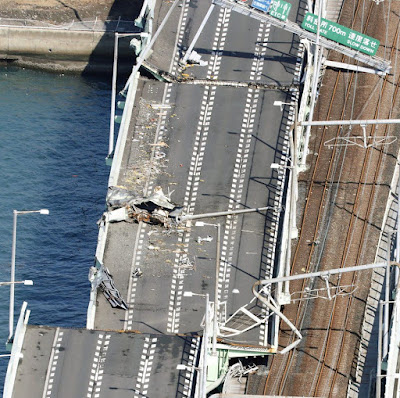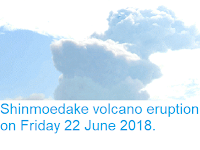At least ten people have been killed and more than 200 have been injured after Typhoon Jebi made landfall on the south coast of Honshu Island, Japan, on Tuesday 4 September 2018, bringing with it winds of up to 216 kilometres per hour. The storm led to over a million people being advised to evacuate their homes, and tens of thousands of homes and businesses being left without power. Over 700 flights to and from Japanese airports were cancelled, and road, rail, and shipping routes were all severely disrupted.
Damage to buildings in Osaka caused by Typhoon Jebi. EPA.
Tropical
storms (called Typhoons in the West Pacific Ocean) are caused by solar energy heating the air above the oceans,
which causes the air to rise leading to an inrush of air. If this
happens over a large enough area the in rushing air will start to
circulate, as the rotation of the Earth causes the winds closer to the
equator to move eastwards compared to those further away (the Coriolis
Effect). This leads to tropical storms rotating clockwise in the
southern hemisphere and anticlockwise in the northern hemisphere.These
storms tend to grow in strength as they move across the ocean and lose
it as they pass over land (this is not completely true: many tropical
storms peter out without reaching land due to wider atmospheric
patterns), since the land tends to absorb solar energy while the sea
reflects it.
Damage to a bridge in Osaka Bay that was hit by a tanker during Typhoon Jebi. Reuters.
The low pressure above tropical storms causes water to rise there by ~1 cm for every millibar drop in pressure, leading to a storm surge that can overwhelm low-lying coastal areas, while at the same time the heat leads to high levels of evaporation from the sea - and subsequently high levels of rainfall. This can cause additional flooding on land, as well as landslides, which are are a common problem after severe weather events, as excess pore water pressure can overcome cohesion in soil and sediments, allowing them to flow like liquids. Approximately 90% of all landslides are caused by heavy rainfall.
Vehicles swept into a pile by Typhoon Jebi in Kobe. Sky News.
See also...
Follow Sciency Thoughts on Facebook.









